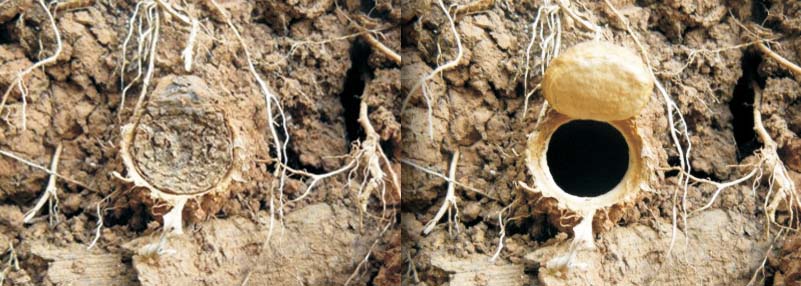- New Species
- Strophaeus sebastiani
- Tessaropa elizabeth
- Anelaphus cordiforme
- Epropetes tristis
- Chucantí Salamander, Bolitoglossa chucantiensis
- Chucantí Tink Frog, Diasporus majeensis
- Chucantí Centipede Snake, Tantilla berguidoi
- Anthurium annularum
- Anthurium chucantiense
- Heliconia berguidoi
- Photinus interdius
An incredible 21 species new to science have been described from the Cerro Chucantí Private Nature Reserve to date. These vary widely, from microscopic, parasitic fungi to a day-flashing firefly, a cryptic songbird, and more. Many others are in process of being described.
Why are so many species new to science found at Chucantí?
The higher elevations of the reserve contain a unique “island” of cloud forest habitat. Many of the species living in this cooler environment cannot survive at lower elevations, so the surrounding landscape traps them within the cloud forest. Chucantí is especially isolated, being more than 100 kilometers from the nearest cloud forest!
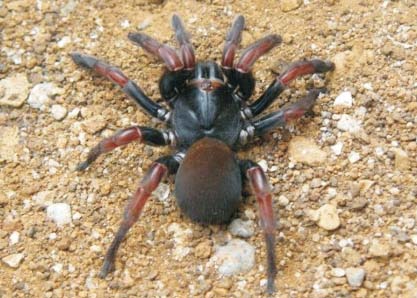
Strophaeus sebastiani
Conservation status not yet evaluated [NE]
This was the first Strophaeus species and only the second from the family Barychelidae known from Panama. Due to limited information, direct comparisons between S. sebastiani and related species were difficult. However, this group is known to have high rates of endemism. The wide geographic separations among S. sebastiani and its relatives was enough to consider it a new species (other Strophaeus species occur in Brazil and Peru). It was named in honor of Sebastián Miranda, son of the first author of the describing paper for this species.

Males of this species are all black, and smaller than females (~21.5 mm vs. ~27.1 mm long). The picture at the top of this page shows a female.
This species builds "trap-door" shelters similar to those of related species. The original specimens were found in open areas ~800 m above sea level. This species is currently only known from Cerro Chucantí, where it may be endemic.
References
Miranda, R & S Bermúdez (2010). Strophaeus sebastiani, nueva especie de Barychelidae (Araneae: Mygalomorphae) de Panamá. Boletín de la Sociedad Entomológica Aragonesa. 175-179. (Link)

Tessaropa elizabeth
Conservation status not yet evaluated [NE]
A long (~9.3 mm) cerambycid with completely divided eyes. Distinguished from other species in its genus by its orange pronotum with a dark central line and orange-tipped antennae. The first Tessaropa species described from Central America, this species was named in honor of Elizabeth Anne Bezark, daughter of the first author of the describing paper, who “has been known to collect a cerambycid or two from time to time”.
Known to occur at 875 m above sea level at Cerro Chucantí, where it may be endemic. The original specimens were collected after being attracted to white light.
References
Bezark, LG, WH Tyson & NM Schiff (2013). New species of Cerambycidae from Panama, with new distribution records (Coleoptera: Cerambycidae). Zootaxa. 3608(4): 273–277. (Link)
Bezark, LG. Ceryambicidae species details. New World Cerambycidae Catalog. (Link)

Anelaphus cordiforme
Conservation status not yet evaluated [NE]
A. cordiforme is similar to two Mexican species, but unique for the heart-shaped mark on the final third of its elytra (cordiforme meaning “heart-shaped” in reference to this mark). Otherwise mostly reddish-brown or brown, with somewhat lighter legs.
This species is currently only known from Cerro Chucantí, where it may be endemic. The original specimens were collected after being attracted to mercury vapor light.
References
Bezark, LG, WH Tyson & NM Schiff (2013). New species of Cerambycidae from Panama, with new distribution records (Coleoptera: Cerambycidae). Zootaxa. 3608(4): 273–277. (Link)
Bezark, LG. Ceryambicidae species details. New World Cerambycidae Catalog. (Link)
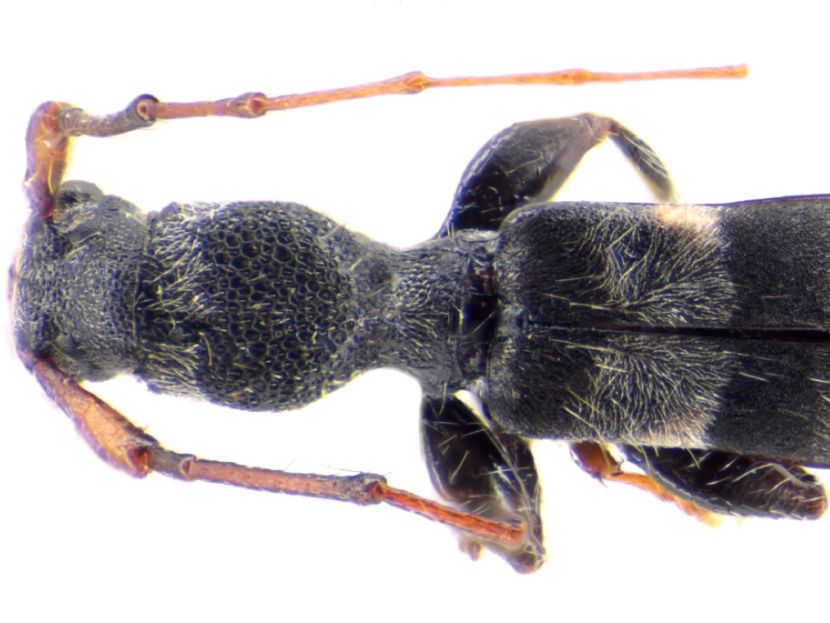
Epropetes tristis
Conservation status not yet evaluated [NE]
A mostly black cerambycid, though it appears banded with gray due to white hairs covering certain sections. The specific name tristis, meaning “sad” in Latin, is in reference to its mostly dark color.
Known to occur 850 m above sea level at Cerro Chucantí, where it may be endemic.
References
Martins, UR & MHM Galileo (2013). New species and records of Cerambycinae and Lamiinae (Coleoptera: Cerambycidae) from the Neotropical Region. Zootaxa. 3683(5). (Link)
Bezark, LG. Ceryambicidae species details. New World Cerambycidae Catalog. (Link)
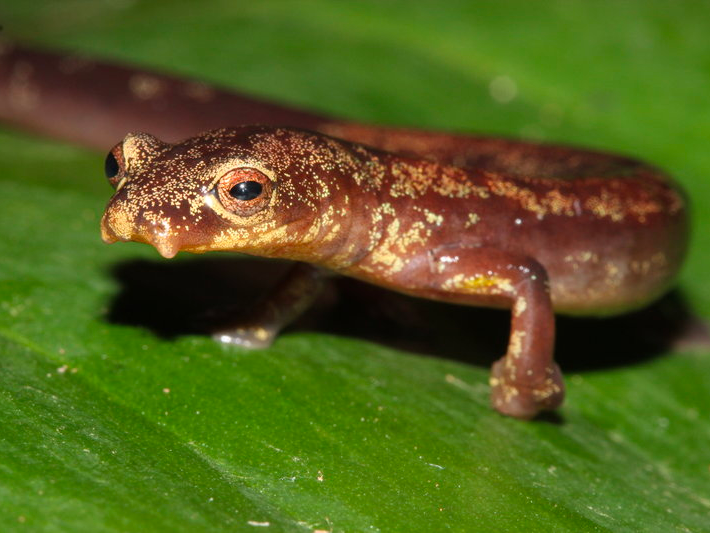
Chucantí Salamander
Bolitoglossa chucantiensis
Critically endangered [CR]
A long salamander with completely webbed feet, B. chucantiensis belongs to the most diverse genus of salamanders worldwide. Its top color varies from dark brown to reddish (Figure 1), sometimes with patches of gold speckling.

Lives in understory foliage in eastern Panamanian montane forest ~1,400 m above sea level. It has been found active at night on leaves a few meters above the ground, usually shortly after rain. This species is currently only known from Cerro Chucantí, where it was found (thus the specific name, chucantiensis) and is considered endemic.
B. chucantiensis has been listed as Critically Endangered [CR] by the International Union for the Conservation of Nature (IUCN) since 2019 due to its small known distribution (~2 square kilometers) and local threats from agriculture and logging.
References
 iNat Observations
iNat Observations
 IUCN
IUCN
Batista, A. (2014). A new species of Bolitoglossa (Amphibia: Plethodontidae) from eastern Panama, with comments on other members of the adspersa species group from eastern Panama. Mesoamerican Herpetology. 1: 97-21. (Link)
Garces, OA, M Miranda, RDF Magallón & A Batista (2016). Second individual of a recently discovered species of salamander, Bolitoglossa chucantiensis (Caudata: Plethodontidae), from eastern Panama. Mesoamerican Herpetology. 3.4: 1082-1084. (Link)
IUCN SSC Amphibian Specialist Group. (2020). Bolitoglossa chucantiensis (Caudata: Plethodontidae), from eastern Panama. The IUCN Red List of Threatened Species. 2020: e.T77345748A87854884. (Link)

Chucantí Tink Frog
Diasporus majeensis
Critically endangered [CR]
This species has been listed as Critically Endangered [CR] by the International Union for the Conservation of Nature (IUCN) since 2019 due to its small known distribution (~2 square kilometers) and local threats from agriculture and logging.
Identification
A small frog (1.5 - 2.5 cm) with a rounded nose. Skin is mostly smooth with small, scattered warts on top. Brown or reddish overall, sometimes with dark markings above. Vocal sac and underside translucent. Only the lower part of the ear (about half of the ring) is visible, membrane absent. Finger I is shorter than finger II, and the fingertips have expanded pads (less obvious on finger I) without fringes or webbing.
Sex differences
Male (15.3 - 21.8 mm) smaller than female (22.3 - 25.5 mm).
Song
Advertisement call a single, short note (0.001 - 0.002 seconds) given about 12 times per minute. Said to resemble a whistle.
Habitat and distribution
Eastern Panamanian montane forest > 1,300 m above sea level. This species is currently only known from Cerro Chucantí, where it is considered endemic.
Biology and natural history
One of the most locally abundant species in the Reserve’s cloud forest. Usually found 0.5 - 2.0 m above the ground in bromeliad foliage, it hides in bromeliad leaves during the day. This species has been heard calling at night around the end of the dry season.
Diet
Not officially known, but expected to be small arthropods (e.g., crickets, cockroaches, and ants).
Etymology
The specific name references the Cordillera de Majé, the mountain range containing Cerro Chucantí.
References
 iNat Observations
iNat Observations
 IUCN
IUCN
Batista, A., G. Köhler, K. Mebert, A. Hertz & M. Vesely (2016). An integrative approach to reveal speciation and species richness in the genus Diasporus (Amphibia: Anura: Eleutherodactylidae) in eastern Panama. Zoological Journal of the Linnean Society. 178: 267-311. (Link)
Medina, D., R. Ibáñez, K.R. Lips & A.J. Crawford (2019). Amphibian diversity in Serranía de Majé, an isolated mountain range in eastern Panamá. ZooKeys. 859: 117-130. (Link)
Batista, A., K. Mebert, M. Miranda, O. Garcés, R. Fuentes & M. Ponce (2020). Endemism on a threatened sky island: new and rare species of herpetofauna from Cerro Chucantí, Eastern Panama. Amphibian & Reptile Conservation. 14(2) [General Section]: 27–46 (e237). (Link)
IUCN SSC Amphibian Specialist Group. (2020). Diasporus majeensis. The IUCN Red List of Threatened Species 2020: e.T152342985A152343015. (Link)
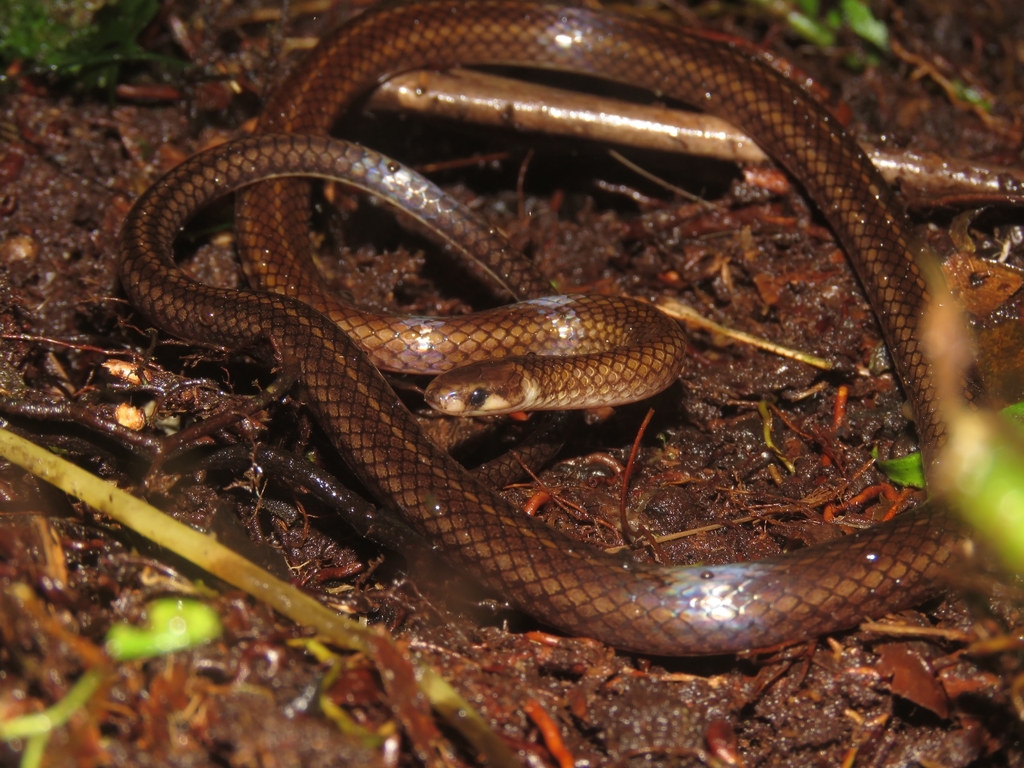
Chucantí Centipede Snake
Tantilla berguidoi
Conservation status not yet evaluated [NE]
Although not yet evaluated by the International Union for Conservation of Nature (IUCN), the authors of the describing paper for this species have suggested it should be considered Critically Endangered [CR] due to its small geographic distribution. When it was described, T. berguidoi was determined to have the highest environmental vulnerability score of any species of Tantilla.
Identification
The coloration of this species (having pale lateral and mediodorsal stripes on a dark background and a head with a pale neck collar) places it in the reticulata section of the taeniata group.
The following describes the male, female not yet described.
A small, thin snake (~40.8 cm long) with a head slightly broader than its body. The dark cap on its head is separated from the rest of the body by a faint pale collar. Body striping is important for identification:
- Pale brown mediodorsal stripe restricted to the middle half of the mediodorsal scale row, bordered on either side by a dark dorsolateral stripe ~2.5 scales wide.
- Dark ventrolateral stripe 2.5 scales wide present in scale rows 1, 2, and the first portion of row 3.
- Dark dorsolateral and ventrolateral stripes are separated by a pale brown stripe 2 scales wide.
Habitat and distribution
Eastern Panamanian montane forest > 1,000 m above sea level. This species is currently only known from Cerro Chucantí, where it is considered endemic.
Biology and natural history
Apparently active year-round in leaf litter on the forest floor. A secretive and rarely encountered species, T. berguidoi may be primarily nocturnal (most individuals observed to date were found at night).
Etymology
This species received its name in honor of Guido Berguido, founder of ADOPTA and the Cerro Chucantí Private Nature Reserve.
References
 iNat Observations
iNat Observations
Batista, A., K. Mebert, S. Lotzkat & L.D. Wilson. (2016). A new species of centipede snake of the genus Tantilla (Squamata: Colubridae) from an isolated premontane forest in eastern Panama. Mesoamerican Herpetology. 3(4): 948-960. (Link)
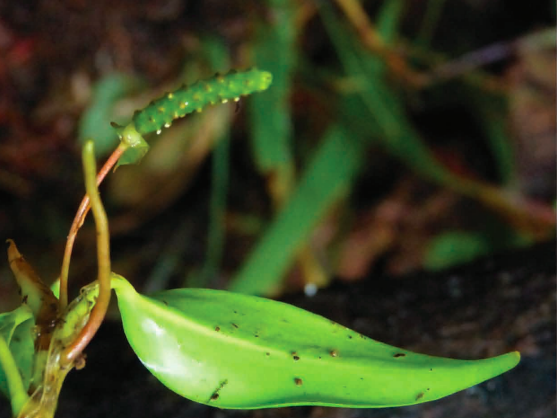
Anthurium annularum
Conservation status not yet evaluated [NE]
Due to its restricted range and threats from local agriculture and logging, the authors of the describing paper for this species have suggested A. annularum should be considered Critically Endangered [CR].
Identification
A hemiepiphytic climbing herb with stems to 1 m long. The swollen, ring-shaped structures at the internodes are a defining characteristic.
Foliage is lance-shaped, green and semi-glossy. Flowering structure has a reddish stem 1.5 - 3.5 cm long; small, green or whitish green spathe; and erect, yellowish green spadix up to 1.9 cm long. Flowers have whitish anthers, 3 - 4 visible on main spiral and 2 - 3 on the alternate spiral. Fruiting structure hanging, with a spathe that tends to fall off; spadix larger than when flowering; flowers turning reddish-purple. Berries round, light green to greenish white, a portion eventually turning translucent, containing 1 - 2 seeds.
Habitat and distribution
Canopy of premontane wet forest/tropical wet forest ~1,325 m above sea level, in habitats dominated by Quercus, Sloana, Oreomunnea, and Magnolia species. This species is currently only known from Cerro Chucantí, where it is considered endemic.
Biology and natural history
Notable for growing 25 - 30 m above the ground in the canopy, together with various species of orchids.
Phenology
The original specimen was observed flowering & fruiting in August.
Etymology
Specific name is from the Latin "annularis", meaning ring-like, in reference to the ring-shaped swellings at the nodes of this plant.
References
Ortiz, OO., R.M. Baldini, G. Berguido & T.B. Croat (2016). New species of Anthurium (Araceae) from Chucantí Nature Reserve, eastern Panama. Phytotaxa. 255(1): 047–056. (Link)

Anthurium chucantiense
Conservation status not yet evaluated [NE]
Due to its restricted range and threats from local agriculture and logging, the authors of the describing paper for this species have suggested A. chucantiense should be considered Critically Endangered [CR].
Identification
An epiphytic herb with short stems (~10 cm long). The areas between the nodes are longer lower down the plant and shorter near the apex (1 - 1.5 cm long). Foliage with quite long (8 - 23 cm) petioles; leaves 2 - 3 times longer than the petioles, large and narrowly oblong (5.5 - 7.4 times longer than wide), dark green and semi-glossy above, paler and matte below. Flowering structure erect; stem quite long (26.5 - 54 cm); spathe green to medium green, bending backwards towards the stem 0.2 - 2cm below the spadix; spadix rounded, erect, 5.7 - 12.5 cm long, yellowish green turning pale orange lower down. Flowers with slightly protruding stamens, translucent filaments, yellowish anthers, 4 visible in main spiral and 3 - 6 in the alternate spiral. Fruiting structure hanging; spathe green with reddish margins; spadix 8.5 cm long, about 6.5 times longer than wide; flowers red. Berries narrowly ovoid and pointed at the apex, orange red, ~1 cm long when fresh, containing 2 seeds.
Habitat and distribution
Understory of premontane wet forest/tropical wet forest between 963 - 1,325 m in elevation. This species is currently only known from Cerro Chucantí, where it is considered endemic.
Biology and natural history
Usually 0.2 - 3 m above the ground in association with other understory plants such as Juanulloa wardiana, Calathea spiralis and other aroids.
Phenology
The original specimen was observed flowering & fruiting in August and September.
Etymology
Named for Cerro Chucantí, where this species was first discovered.
References
Ortiz, OO., R.M. Baldini, G. Berguido & T.B. Croat (2016). New species of Anthurium (Araceae) from Chucantí Nature Reserve, eastern Panama. Phytotaxa. 255(1): 047–056. (Link)
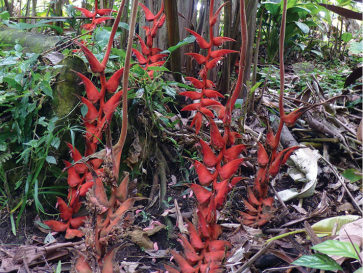
Heliconia berguidoi
Critically endangered [CR]
A large herb resembling a banana plant, but with a long (to 220 cm) hanging flowering structure. The specific coloration of the flowering structure – red with golden hairs, containing pink flowers – is unique to this species. It was named in honor of Guido Berguido, founder of ADOPTA and the Cerro Chucantí Private Nature Reserve.
Grows in mature and regenerating secondary premontane forest around 800 - 900 m above sea level. This species is currently only known from Cerro Chucantí, where it is considered endemic. The authors of the describing paper for this species have suggested it should be considered Critically Endangered [CR] because of its small distribution (estimated at 4 km2) and threats from local agriculture and logging practices.
References
Flores, R., C. Black & A. Ibáñez (2017). A new species of Heliconia (Heliconiaceae) with pendent inflorescence, from Chucantí Private Nature Reserve, eastern Panama. Phytotaxa. (77): 21-32. (Link)
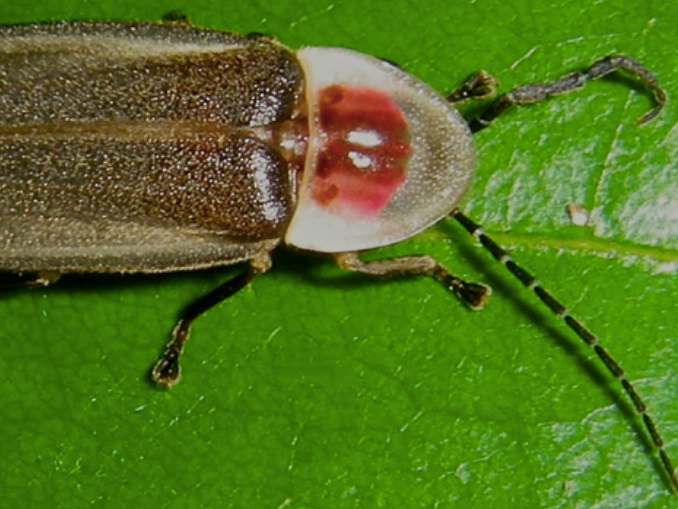
Photinus interdius
Conservation status not yet evaluated [NE]
Like many fireflies, males of this species display to females by flashing light while flying. However, this may be the only species to flash in the daytime rather than at night. While there are other fireflies known to be active during the day, they do not light up (most have reduced or absent lanterns and communicate via pheromones instead).
Daytime flashing was probably normal for the ancestors of modern fireflies, but this is likely a recent change for P. interdius. More research is needed to determine why P. interdius has adapted to flash during the day, but the current hypothesis is that it may make it easier to hide from nocturnal predators such as bats. The specific name “interdius” is Latin meaning during the day/by day to reflect this species’ unusual courtship timing.
Video of the light display of a Photinus interdius male by Dr. Fredric Vencl:
Lives in lowland rainforest, to 800 m in elevation. Distributed on Panama’s Pacific slope, at least from Central Panama to the western border of the Darién province (Cerro Chucantí). This species’ coloration varies regionally:
Central Panama: Tan overall, with striped antennae. Finely perforated pronotum with wide, pale margin and narrow medial groove extending halfway to the apex. Two tan stripes follow this medial groove, flanked by two larger, salmon-colored stripes.
Cerro Chucantí: More yellowish overall, especially in the pronotum where the salmon stripes are replaced by yellow stripes. Individuals of this population are also smaller than in Central Panama (averaging 18 mm long).
References
Vencl, F.V., X. Luan, X. Fu & L.S. Maroja (2017). A day-flashing Photinus firefly (Coleoptera: Lampyridae) from central Panamá: an emergent shift to predator-free space? Insect Systematics & Evolution. (Link)

